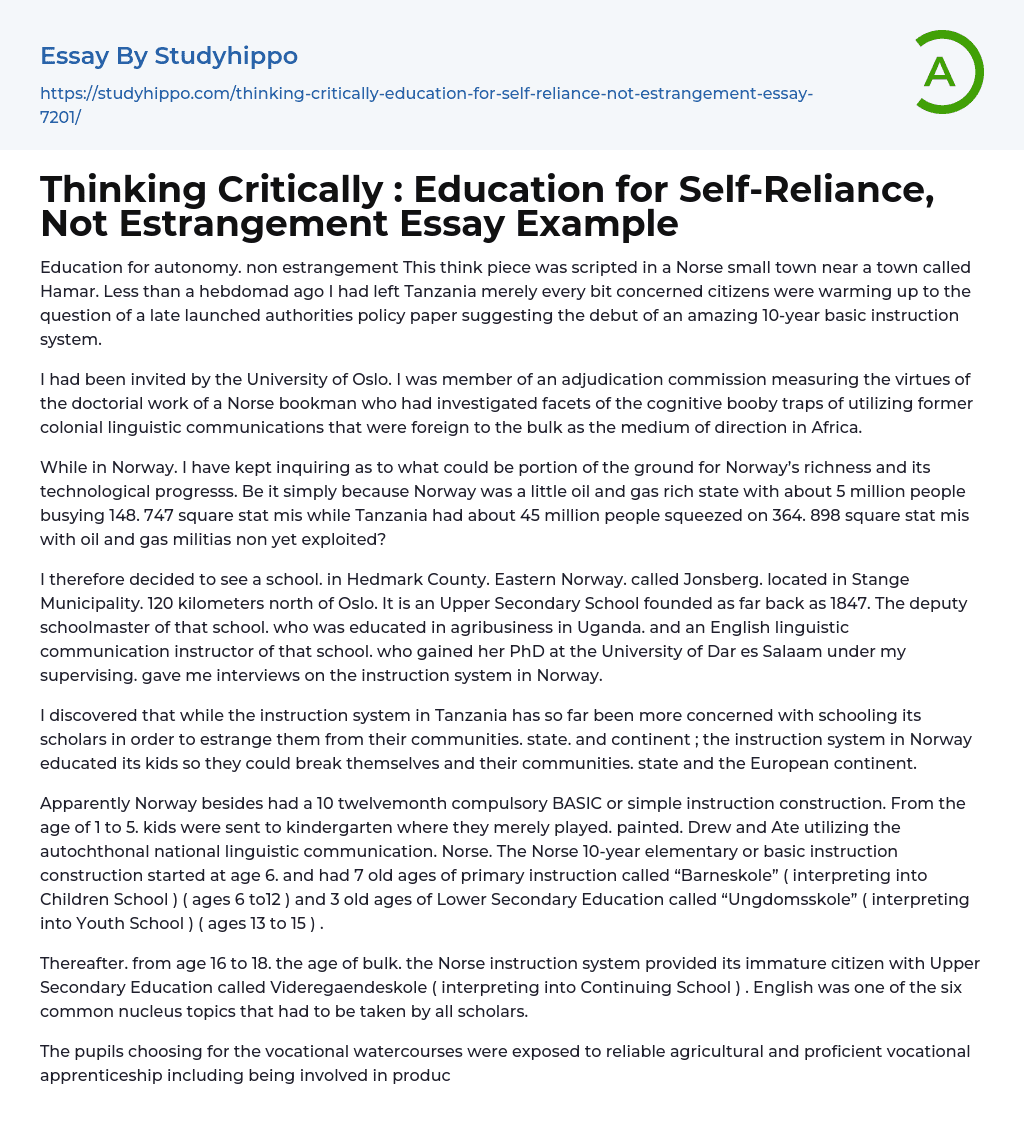

Thinking Critically : Education for Self-Reliance, Not Estrangement Essay Example
The following think piece was written in a small town near Hamar, Norway. Recently, I had left Tanzania where citizens were discussing a government policy suggesting the implementation of a 10-year basic education system. I was invited by the University of Oslo to be part of a commission that evaluated a Norwegian scholar's doctoral work on the cognitive challenges of using colonial languages as the medium of instruction in Africa. While in Norway, I wondered about the reasons behind the country's prosperity and technological advancements. Could it be because Norway is a small oil and gas rich country with a population of about 5 million, compared to Tanzania's 45 million people squeezed into a larger area with untapped oil and gas reserves? This led me to visit Jonsberg, an Upper Secondary School founded in 1847 located in Stange Municipality in H
...edmark County, Eastern Norway. The deputy schoolmaster of Jonsberg, who studied agriculture in Uganda, and an English language teacher, who earned her PhD under my guidance at the University of Dar es Salaam, were welcoming hosts during my visit.I conducted interviews about the education system in Norway, and compared it to the system in Tanzania. I found that while Tanzania focuses on schooling scholars to distance them from their communities, Norway's education system aims to empower both individuals and their communities. Norway also has a mandatory 10-year basic education structure. Children from ages 1 to 5 attend kindergarten, where they engage in activities using the native language, Norwegian. Starting at age 6, there is a 10-year elementary education system, which includes 7 years of primary education known as "Barneskole" (ages 6 to 12) and
years of lower secondary education called "Ungdomsskole" (ages 13 to 15). After that, from ages 16 to 18, the Norwegian education system offers upper secondary education called "Videregaendeskole" (Continuing School). All students are required to take English as one of the six core subjects. Those who choose vocational courses also receive hands-on training in agriculture, technical skills, and production activities within school farms, garages, and workshops.The text discusses an academic program at Jonsberg where only students in the Academics stream were offered specialized subjects such as chemistry, physics, and biology. Other students were given a combination of Norse (Norsk), math, English, social sciences, natural sciences, and physical education. Although Jonsberg had a large area of farmland and a staff of 50, it only had 240 students. These students showed me around the school's animal sheds and engineering workshops, demonstrating their knowledge gained from their education. They were proud to practice their English with me, but otherwise, everyone spoke and read in Norsk. The text suggests that Tanzania should consider implementing Mwalimu Julius Nyerere's Education for Self-Reliance through the proposed mandatory 10-year basic education structure. It also argues for using Kiswahili as the primary language of instruction at all levels, with English taught as a foreign language alongside French.Tanzania should focus on providing a 10-year primary education that promotes self-confidence, rather than simply offering more schooling that leads to individuals feeling alienated from their own community, state, and continent. This applies to individuals of Arabic, Portuguese, and even Chinese backgrounds.
- Academia essays
- Higher Education essays
- Language Learning essays
- Studying Business essays
- Education System essays
- Study essays
- First Day of School essays
- Scholarship essays
- Pedagogy essays
- Curriculum essays
- Coursework essays
- Studying Abroad essays
- Philosophy of Education essays
- Purpose of Education essays
- Brainstorming essays
- Educational Goals essays
- Importance Of College Education essays
- Brown V Board of Education essays
- The Importance Of Higher Education essays
- Online Education Vs Traditional Education essays
- Academic And Career Goals essays
- Academic Integrity essays
- Brown Vs Board Of Education essays
- Distance learning essays
- Technology in Education essays
- Vocabulary essays
- Writing Experience essays
- Importance of Education essays
- Early Childhood Education essays
- Academic Degree essays
- Academic Dishonesty essays
- School Uniform essays
- Academic writing essays
- Cheating essays
- Bachelor's Degree essays
- MBA essays
- College Life essays
- Grade essays
- Diploma essays
- Phonology essays
- Sentence essays
- Filipino Language essays
- Pragmatics essays
- Millennium Development Goals essays
- History Of Education essays
- Graduate School essays
- Middle School essays
- School essays
- Special Education essays
- University essays



